Massage Ball/Lacrosse Ball
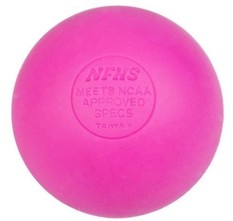
Resistance Bands
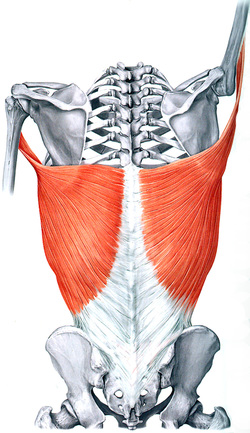 Those pesky lats
Those pesky lats 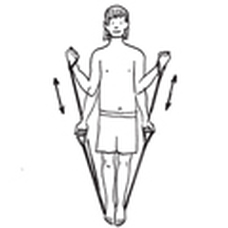
Washing Line
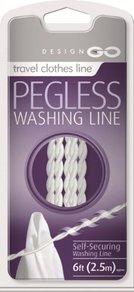
Vibram Five Fingers
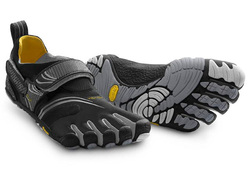
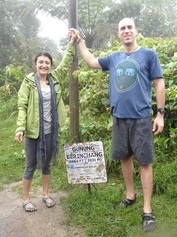 The Five Fingers at the top of
The Five Fingers at the top of Gunung Berinchang, Malaysia
Straightening Iron
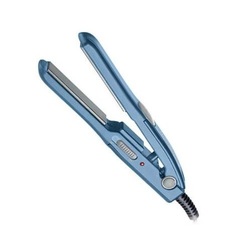
After a brief summer hiatus, we finally come to the conclusion of our Essential Travel Gear series! In our last two posts we’ve covered essential travel gear for keeping your money safe and the best electronics to take for world travel. Now it’s time to talk about the little things that make a big difference in the long run. When it comes to staying healthy and keeping clean, a few little pieces of gear can make all the difference. Let’s take a look inside our bags... Massage Ball/Lacrosse Ball  This might win the award for least expected, most amazing/useful gift received on our travels. When we first started out on our trip, we dropped by Columbus to visit our friends Nat & Rayn. We had a great time visiting food trucks and eating delicious meringues. Nat is a massage therapist and before we left he gave me a simple lacrosse ball. He said I could use it to work out knots on the road. OMG, was he right! This little ball has been our constant companion – you can roll your feet on it at the end of a hard day for instant relief, or put your back to a wall with the ball there to massage out knots in your lower or upper back. Calves cramping after a long day of walking? Rub the ball along the line where the shin meets the muscle and feel the aches melt away. Costing nearly nothing, this is a must have for any travelers! Thanks Nat! Resistance Bands Those pesky lats Those pesky lats As we traveled, yoga was our primary method for staying fit. After all, with yoga you only need a small space on the floor or ground to get a full body workout. But there are a couple muscle groups that even the most intense yoga workout leaves relatively untouched - mainly the biceps and the latissimus dorsi (back muscles). Typically you need equipment only found in a gym to work those muscles, which isn't available when hopping around the globe! By doing push-ups on the floor of your hotel, you can keep your pecs (chest) and triceps (the back of your arms) healthy and toned while traveling. But there is no easy way to work out your back and biceps. This is where the bands come in. To work both lats and biceps at one time, find a tree or a sturdy radiator in your room and wrap the band around it. Then grab each end, bend your knees slightly, and pull the band towards you. You want your elbows to scrape along your ribs and to pull your hands back to your ribs. This “rowing” motion will work both your biceps and your lats.  Alternatively, you can stand on the band and do bicep curls like the picture on the right. Simply spread your legs further apart to work the biceps more (though this movement will not work your back like the above movement). By doing this and push-ups regularly you would never know I hadn’t been to a gym in over two years! Resistance bands come in different lengths and levels of tension, but the ones we used are made by Fitness Gear (click here for the link). We particularly liked these resistance tubes because you don't need the handles, which are unnecessary when trying to pack ultra-lite. Just build up your wrist strength and grab the ends (like the in the picture above) without handles. I used the "heavy" band and Neda used the "light" band – they easily fit around the circumference of our Porter packs. Washing Line  When you’ve only got two days in a place to explore, I guarantee that you’re not going to want to sit and do laundry while time passes by. And if you are traveling ultralite, it often doesn’t make sense to pay to get a whole load done. So you end up washing a lot of shirts and underwear in the sink with a bar of soap. But what to do about drying? That is where a clothes line ends up making life a lot easier. Just a simple piece of thin rope can do, but I like a design like this GoTravel Pegless Washing Line. It has hooks on either end as well as suction cups that can attach to the hooks, giving you maximum versatility. We could put the hooks around an outside balcony and dry our clothes or if no balcony, suction the ends to the bathroom tiles. It’s a tiny, but very useful thing for long-term travelers especially! Vibram Five Fingers  I mentioned these shoes in a previous post, but they deserve one more glance. The Vibram Five Fingers are quite popular now as a “minimalist” running shoe. The sole is so thin that it is almost like walking barefoot, and supporters say that it strengthens muscles in your feet that regular shoes don’t and encourages correct form in walking and running. I don’t know about all that, but I do know that they weigh nearly nothing. Neda’s model was the Bikila Shoe, weighing in at 7.5oz and Jeff’s the Komodo Sport (pictured), which at nearly double the size, still weigh in at only 14.5oz! Compare that to an average athletic shoe and you are saving 1.5-2.5 pounds of weight!  The Five Fingers at the top of The Five Fingers at the top of Gunung Berinchang, Malaysia The shoes really shine in their versatility. Forget about heavy hiking boots – we used these to climb the highest peaks of New Zealand and trek through the thickly wooded jungles of the Cameron Highlands in Malaysia. We used them as water shoes for snorkeling (though they don’t recommend that) and of course as shoes for morning runs. Want to do yoga outside? These are a great solution. And when you think about all the things you can do with that extra 2lbs of weight, they really are a no-brainer for travelers. We loved our five fingers! Straightening Iron  From trekking through jungles to navigating through the humidity of India, it is hard to keep your hair looking good! One of Neda's favorite little tools was this mini straightening iron. It is so powerful, that she was able to straighten all of her hair with it and smooth the frizziness away! She knew she made the right choice, when she found out that fellow traveler and hair stylist, Shea, also wouldn't travel without her mini BaByliss PRO Nano. This tool is so small that it just fits on the side of the pack and doesn't take up any extra space or adds any weight. It is also dual voltage to be used worldwide with the appropriate adapters. That wraps up our series on essential travel gear for trotting the globe. Hope that this gear helps you on our journey and have a great trip!
2 Comments
After leaving Chiang Mai, we headed further North to the city of Chiang Rai. Situated close to the “Golden Triangle” (where the border of Laos, Myanmar, and Thailand meet), this region became infamous for its sprawling opium fields in the 1960’s-1980’s. Now most of the opium has been replaced by other legal cash crops (tea, coffee, corn, etc…), but tourists still come to tour the area, which is rich in natural beauty. 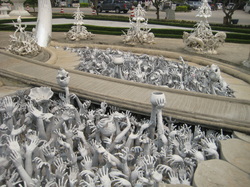 The Suffering Masses Having only a short time, we opted to explore the artistic and sacred side of Chiang Rai – represented by two opposing colors: Black and White. Our first stop was the White Temple (Wat Rong Khun), a recent architectural achievement by artist Chalermchai Kositpipat. Kositpipat veered away from the traditional gold coloring of Thai temples because he thought white better represented the purity of the enlightened state than the mercantile color of gold. The outside of the temple is a magnificent sight to behold – glittering white in the light, its sharp lines bringing an immediate feeling of awe. It almost oddly resembles a winter wonderland that somehow found itself in steamy Thailand. The entryway to the temple portrays humans and demons reaching up out of a pit of suffering – a symbol the artist says represents the suffering all beings must go through before reaching enlightenment. After passing over a bridge guarded by two giant demons, visitors enter the temple where a large white marble Buddha sits. On the wall in front of the Buddha are scenes of demons feeding on human suffering – missiles, whisky, pollution, etc… while on the walls on the side and behind the Buddha faithful practitioners are portrayed moving towards the heavenly realms. Perhaps most oddly, on the “demon wall”, there is a variety of science fiction and pop-culture icons moving around the demons. We saw Keanu Reeves from the matrix, the Hulk, Spiderman, the Predator, Darth Vader, even an Angry Bird from the iPhone game! Needless to say, the artist seemed to get a little carried away at this point as we struggled to understand what we were seeing and how it related to the overall message. 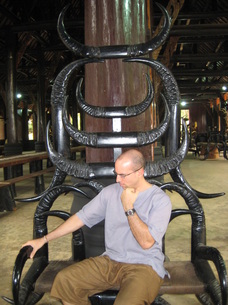 Jeff doing his best Conan impersonation The White Temple was about 13 kilometers south of town and after visiting, we headed about 25 kilometers north to the grounds of the Black Temple (Baan Si Dum). We found it to be opposite not just in color, but in style as well. Baan Si Dum is a complex of many buildings sharing the theme of artist Thawan Duchanee. It is dominated by a large Black Temple, filled with animal skins laid on long wooden tables and black chairs with buffalo horns at the top. There are also intricate wooden carvings depicting demons struggling with each other on the doorways. The rest of the grounds is littered with buildings that the artists didn’t have open that day. But walking among we saw common themes – animal bones (shark jaws, monkey skulls, etc…) and furs laid out domestically with bone carved furniture and Buddhist iconography. It was almost like a vision of a barbaric jungle king’s palace after he had converted to Buddhism. After the “bling” of the white temple, the Black Temple’s eerie scenes seemed to call the visitor towards the contemplation of death and the ephemeral aspect of our existence. Some writers have described these temples as representing the heaven and hell of Buddhism. Neda and I couldn’t help but chuckle as we read that description. How ironic that these two temples have come to represent as stark a dualism as heaven and hell. In actuality, Buddhism is all about moving beyond the idea of dualism to find the interconnected whole. Heaven and hell, in this regard, are two sides of the same coin. We can be in paradise with our self-focused thoughts and find pain and alienation or we can be in hell with a right understanding of our interconnectedness and find peace and repose. Perhaps thinking of the black and white temples as two separate pieces is the problem in the first place. If we go beyond their differences and find the common message of impermanence and surrender that they implore, we find a deeper meaning than either piece has on its own. We left Chiang Rai this morning, drove 3 hours and crossed the border into Laos. Our next stop is the Bokeo Nature Reserve where we will zipline hundreds of meters above the jungle floor in search of the elusive Black Gibbon! In the meantime, see the rest of Chiang Rai and the two temples here: http://flic.kr/s/aHsjyNTZGh After leaving Baan Hom, Neda and I decided to take a day to visit the Elephant Nature Park about 65km outside of Chiang Mai. The founder of the park, Sangduen Chailert (nicknamed “Lek”) has created a sanctuary there for 35 elephants that have been rescued from logging operations, trekking jobs, and landmine accidents. She also cares for elephants whose parents have died, leaving them orphaned with no one to care for them. 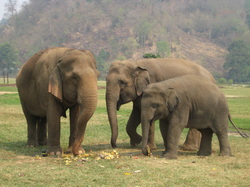 A "Family" at the Sanctuary Sanctuaries like this one are increasingly necessary as over the past 100 years the population of elephants in Thailand has plummeted from 100,000 to a mere 3,000. This decline was exacerbated in 1989 when logging was banned in Thailand. Elephants whose main job was dragging cut wood out of forests (which sadly was destroying their own habitat) found themselves out of work and often abandoned. The animals would then search for food and be shot by farmers as nuisances when they encroached upon crops. Domesticated elephants also suffered because they weren't suited for life in the wild after undergoing the process of Phajaan, or “The Crush”. In this ancient ritual, an elephant is prepared for a life of work through 3-7 days of torture in a wooden cell too small for its body. A whole village participates in the constant prodding and stabbing of an elephant if it shows any resistance to the process. They also throw in sleep, food, and water deprivation for good measure. The local shaman performs black magic to crush the animal's connection to its mother, and thereby its very soul. Some elephants don't even survive the brutal process, and those that do are irreparably traumatized. This trauma is no small thing considering elephant's 80 year lifespan. The Park felt it was important we saw a video of the process of the Phajaan that had been obtained by a journalist, and I agree that it is something everyone should be aware of. I am providing a link here, but please be aware that it is very hard to watch. Click HERE to see it. 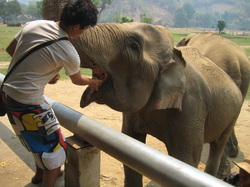 A Mahout Feeding his Elephant The Elephant Nature Park is a special place because it seeks to create new paradigms for our relationships with elephants. Lek believes that domesticated elephants can be trained using positive reinforcement, patience, and love. Each elephant has a mahout (handler) who, instead of using chains and hooks to subdue the animals, uses fruit and baths in the river to reward the elephant for good behavior. The elephants roam freely and create social groups amongst themselves (an amazing feat since they are not related, but are all rescued). Lek and her mahouts' patience seem endless as they lovingly teach and care for their elephants. It is striking how for centuries local people have used only pain and negative reinforcement to train these animals, when a method of love is just as effective and preserves the dignity of the animal. For us Lek’s approach had broader implications about the way we raise our own children and the ways in which we interact with each other in everyday life. How often do we find ourselves trying to resolve a problem by manipulating someone with fear, pain, triggering their insecurity, etc… It is the ego’s quick solution to getting what it wants and it is incredibly destructive both to the person doing the action and the receiver of it. Lek inspired us to see yet again how a path of love, while sometimes requiring more mindfulness, consistency, and patience, pays off in the long run by preserving the spirit of both parties. For Neda and me it was a wonderful day. We fed the elephants fresh bananas, melons, and squash. We learned about their personalities and individual stories. We helped bathe them in the park’s river and got elephant kisses for our efforts. They are truly loving, peaceful creatures whose majesty is inspiring to be around. We experienced their intense loyalty to one another and the nurturing and playful spirit that the elephants were able to partly recapture, despite their abuse at the hands of humans. If you’d like to find out more about what you can do to help the plight of the Asian elephant, you can click HERE. Logging is still perfectly legal in Burma so the need for sanctuaries will not stop anytime soon. But if we can remember Lek and her message of love, there may be hope for the elephants as well as for us. Below are a few pics from our day, to see all of the great shots we captures, click here - http://flic.kr/s/aHsjyKDTfQ. 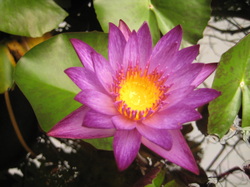 A Lotus Flower in the Garden For the past 3 weeks, we have been living in a small village about 10 km outside of Chiang Mai. The property consists of several old style Thai teak homes and luscious gardens filled with medicinal herbs grown by the proprietor, Homprang Chaleekanha. We are learning a special blend of Thai massage techniques, Thai acupressure, and herbal knowledge that our teacher learned growing up with her grandma in a jungle village and that she refined in her doctorate program in Thai Traditional Medicine. 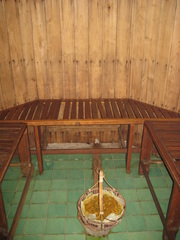 The Sauna before a steam The days go by fast here! We are awakened every morning by the roosters’ crows around 6:30am. After that we do Thai yoga to get the body ready for the day. Thai Yoga is a breath based technique more similar to Tai Chi than vinyasa flow yoga. After a light breakfast we train in Thai Massage for 3 hours. We break for a delicious lunch (Pad Thai, spring rolls, make your own noodle soup, etc…) and continue training until late afternoon. After every day of hard training, we relax our muscles in the custom built herbal steam sauna on the premise. The family uses a blend of herbs they grow in the garden for the sauna. There is Zingiber (an anti-inflammatory root similar to ginger in appearance), Turmeric, Tamarind, tea tree oil, kaffir lime skin, lemon grass, and camphor. It smells wonderful and after cleaning out all the toxins it feels wonderful to dip in the cold pool outside the sauna afterwards. Right after the sauna, all students and guests top the night with a traditional Thai meal and the company of Homprang and her husband Christopher. We have Saturdays off and we usually head into town for some entertainment. We have met many wonderful people from all over the world here including several from Springfield, MO!!! That was probably the most random coincidence yet! Some of these guys are already planning a trip to Bulgaria to visit us and we are planning several trips to other countries to visit the other friends we have made here! 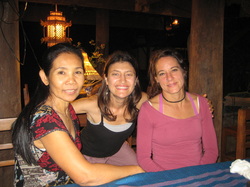 Neda, Homprang, and Candace Our teacher Homprang is a truly fascinating person. She grew up in a small village in the Kanchanaburi area of Thailand. There was no electricity, dirt floors in the homes, a limited monetary system (barter was the main economic interaction) and no hospital. To fill that gap, her family acted as traditional medicine doctors that passed the skill on from generation to generation. They used Thai massage and herbs to treat medical problems in the community. Homprang grew up walking on her grandparents to learn Thai Massage and often helped them prepare herbal tonics, teas, and compresses for medicinal purposes. One fascinating technique that Homprang taught us from her grandmother was the ancient practice of “womb lifting”. Nearly every woman in our class had a tilted or prolapsed uterus that caused them pain in everyday life or during their periods. Often overlooked by Western medicine, a displaced uterus can play a major issue in infertility, urinary incontinence, and chronic low back pain. The Western solution is usually some form of surgery, but through this massage and acupressure technique, the body is relaxed and the uterus restored to its proper place. Many women in our class experienced immediate relief – it was amazing to see! As we have deepened our understanding of Thai massage, we can’t help but notice the similarities of this body work with yoga, meditation, and spiritual growth. As you work with the body, you notice how the breath of the receiver and giver blend and become one. Feeling the muscles relax under your elbow, knee, or thumb, is a release of tension for both. As you move through different positions through the massage, you find yourself in many yoga postures stretching your body as you are helping the person on your mat. In the end, the aim of the practice is not to heal the body, but to make space for the body to heal itself – an activity its been doing quite well for thousands of years. This experience has allowed us a very unique glimpse of Thai culture as we have gotten to know Homprang’s family and their history. We are thankful to have gained a deeper knowledge of how to heal our bodies and a deeper understanding of Thai people. A few more days here and then we head North to Laos! In the meantime, if you want to get on the waitlist for some free Thai Massge, make sure to leave us a comment or send us a note! See all the pics of our time at Baan Hom here: http://flic.kr/s/aHsjys6Vs9
While we waited for our massage training to start, we headed northeast of Chiang Mai via nauseatingly windy roads to the small town of Pai. In the early days of Thai tourism, Pai got a reputation as an ex-pats retreat from the city with a focus on meditation, spirituality, etc… Once it got popular, however, the center of this small mountain town transformed into a tourist hub with corresponding bars and western food restaurants. Still, Pai retains enough of its Thai culture to stay charming despite its popularity. 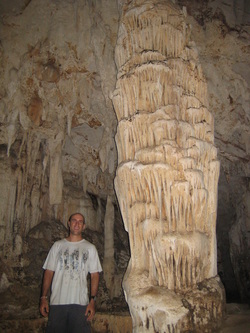 Column in Tham Lot Cave While staying in Pai, we took an overnight trip to Soppong (recently re-named Pangmapha) to visit the amazing Tham Lot Cave, which features the largest cave opening in all of SE Asia. Tham Lot is also home to over 300,000 swifts (tiny birds) who return to the cave at sunset every evening in an amazing aerial show. The drive alone was worth the journey - with sweeping views of the countryside and fresh mountain air. We stayed at a placed called the Cave Lodge, established by an Australian named John and his Thai wife in the early 1980s. It was fascinating to read about John’s life (he wrote a book) about the early days of exploring the numerous caves in the area (Tham Lot Cave is part of one of the largest cave systems in SE Asia). John was exploring Soppong when the opium trade was still in full swing in the area and he survived through the cycles of violence and addiction in the area to establish the Cave Lodge and map out the caves for others to see. At one point he and a crew were underground in a cave for 55 straight hours! They also discovered and began the scientific research on the numerous teak coffins in the area’s caves – remnants of a civilization at least a 1,000 years older than Thai culture. 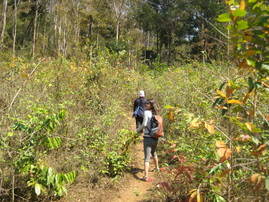 Trekking to the cave entrance with our guide We were inspired by the seeming fearlessness that John had displayed in his life as he explored the dark depths of the caves of Soppong. We got our own little taste of working with fear as we took our 125cc motorbike over some steep back country dirt roads riddled with pot holes to visit the small Karen hilltribe village of Ban Huang Paem. We rolled into town and after perusing the hand woven fabrics that the locals brought out and laid on the street, we hired a guide to take us to the Tham Long Yaow Cave. It was an exhilarating and slightly scary feeling to take our tourism into our own hands as we followed this local tribeswoman deep into the jungle to find a cave that the first Westerners visited only 20 or 30 years ago. As we crawled on hands and knees through the narrow entrance trepidation crept up our spines only to be quickly replaced by awe as the cave’s grandeur erupted around us. Beautiful stalagmites and stalactites littered the landscape and “flow rock” (crystalline formations of rock) glistened as our lights fell over it. 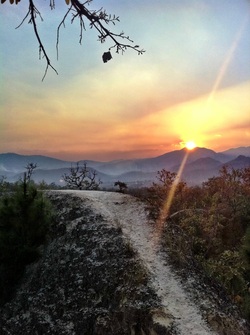 Pai Canyon at Sunset Leaving the caves and returning to Pai, we enjoyed a stay at a mountain lodge where we recharged with stunning views of the mountain while practicing yoga, peaceful days reading in hammocks, and fruit carving. We also explored the beautiful Pai Canyon, the area’s steams baths (fed by the Pai Hot Springs) and some waterfalls reachable by motorbike. One day we decided to hike to the Mae Yen waterfall (which is only accessible by foot), a 14km roundtrip trail that is barely marked, leaving us to just “follow the water” as one local told us. We brought 2 liters water and expected the hike to take 3-4 hours roundtrip, but found we didn’t count on the hilly terrain and numerous water crossings. At one point about 3 hours into the hike, we climbed over a rocky outcropping in the water and had trouble finding the trail. Scared about how long the return trip would take and our dwindling water supply, we contemplated returning to town without seeing the falls. We gave ourselves 20 more minutes to try to find the way. At minute 19, as I ducked under a fallen tree, I saw a glimmer of water falling down the mountain side and heard the dull roar of water crashing upon the rocks. We started to run with exhilaration to the clearing where the waterfall gushed. There were no tourists all the way out here in the jungle – just the sound of the water and the beautiful view. As we hiked back from the falls (the round trip ended up being about 7 hours of hiking), we contemplated how so many of our experiences these past days had almost been derailed by fear. The cave and the hike to the falls seemed an analogy for the spiritual journey. Perhaps each of us must enter our own dark caves to explore, despite the fear it brings up in us. We must somehow find the faith to move into fear and not away from it. At the superficial level it is a belief in our own self-reliance and ability to survive. But at the deeper level it is faith that those same fears can propel us to insights that make life infinitely more vibrant. John from the Cave Lodge moved into his fears and as a result was istrumental in mapping the caves around Soppong and in developing a tourist industry in the area that was beneficial to the local people. For Neda and me, moving through the dark caves and challenging hikes led to a renewed faith in our own abilities, our relationship, and the beauty that lay on the other side of fear. To see the rest of the amazing pics of our time in this region, click here: http://flic.kr/s/aHsjyovm5W. As we visit each new country, one goal we have is to challenge ourselves with a mental task (like language acquisition) as well as a physical skill developed by that culture. The inspiration for this came from Tim Ferris, one of our favorite lifestyle design authors. We see this type of challenge as the perfect way to continue to grow while traveling. It can be easy to become a passive observer of a culture as one travels - just consuming, observing, and judging, as is typical for our minds. But to challenge oneself to immerse in that culture and learn a few of its contributions to the pool of human knowledge is a perfect way to stay physically and mentally sharp. Whether at home or traveling abroad, it seems crucial that everyone find their own "stagnation stoppers" to keep life interesting and to fight off the sleepy malaise that can so easily take hold of body and mind. For the major physical skill here in Thailand, we are doing a month long Thai massage training. We got interested in Thai massage during our wonderful yoga teacher training at Dharma Yoga, where one of our guiding teachers, Camilla Figueroa introduced us to the basics of the practice and philosophy. So what is Thai Massage? I like the description of massage therapist Nephyr Jacobsen, who says: "I've done deep-tissue Swedish massage for 17 years. I mean really deep; no fluff-and-buff stuff here. But it doesn't come close to Thai massage, and nothing I've seen does. It's yoga and Rolfing and acupressure and tapotment and chiropractic and reiki and deep compression work and myofacial release and hydrotherapy with herbs and the power of spirit, all rolled into one." We spent a few days in Chiang Mai researching the different schools and found an amazing teacher that learned Traditional Thai medicine and massage from her grandparents. These techniques were passed down for generations in her family. She has since been certified as a Doctor of Traditional Thai Medicine and Thai Massage, but still cherishes the oral and tactile lineage by which she learned. Her estate is about 9 km from Chiang Mai - check out the site here. We are staying in house #4 – isn’t it beautiful? 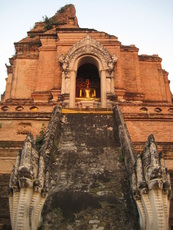 Wat Chedi Luang As for our time in Chiang Mai, we found it to be a city full of growth - for good and ill. On the positive side the city has seen many ex-pats settle within its old walls, leading to a fascinating mix of people. One fellow we met was good friends with Glen Campbell back in the day and drove Merle Haggard to Capital Records to cut his first single! The city is also full of the wonderful temple architecture of the Lanna Kingdom, of which it was once the capital. On the negative side, Chiang Mai seems like it is bursting its britches a bit, with lots of traffic and poor air quality unfitting of such a beautiful mountain location. 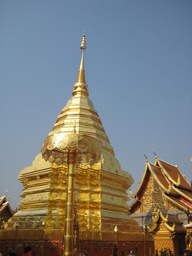 Wat Doi Suthep Like our massage training, which is located 9km south of Chiang Mai, we found that many of our favorite parts of Chiang Mai lie just outside of it. Wat Doi Suthep is a beautiful temple on the mountains surrounding Chiang Mai and the San Kamphaeng Hot Springs and Muang On Caves were great Thai tourist attractions to visit with the locals! At San Kamphaeng we were able to boil quail and chicken eggs in the sulfuric waters, making for a delicious breakfast! We also spent Valentine's Day here and had a really special Thai dinner - Khantoke, where a small tray of several different dishes is served with rice and a whole bowl of fresh herbs! For all the pictures, see this link: http://flic.kr/s/aHsjyNZ2En. Our massage training starts tomorrow and with it comes some stability for the next month. In the meantime, we had a wonderful visit to the mountain towns of Pai and Suppon while we waited for the training to start, so we'll post a blog on those experiences in the days to come.
We have been in Thailand almost 6 weeks now, and are getting increasing insight into Thai Culture. The Thais have a saying, “same same but different,” and that is exactly how we feel about Thailand and its people. Every day we find connection in our similarities and enrichment in our differences. We thought we’d discuss a few of those insights here. As we traveled through Southern Thailand, we noticed a great amount of attention placed on the feet. Thais always take their shoes off prior to entering a home (which is how it is in Bulgaria as well), but they take it to another level by taking their shoes off in the stores such as pharmacies, grocery stores, minimarts, etc. It is also considered rude to sit with the soles of your feet facing a person (or an image of the Buddha). So might be hard to have your legs up on the coffee table in Thailand! We also noticed that people in the South were more reserved in their clothing - probably due to the major Muslim influence of Malaysia. Usually, women would not wear tops that show their shoulders and would never wear bikini. They just go in the water fully clothed (as do Thai men). As we have reached the North, women seem to be more lax about these restrictions but are still a lot more modest than their Western counterparts. 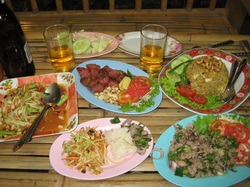 Regarding food and etiquette, it is interesting to note that Thais eat primarily with spoons. At each meal, you are served a fork and a spoon, but the fork is only used to push food onto the spoon. The Thais believe it is uncouth to eat with your fork! We have really taken to eating with our spoons now and it is actually much easier, especially with the rice-centric dishes of Thailand. The Thais are also much more lax related to “food safety”. Eggs are never refrigerated, even in grocery stores, and cooked foods will often sit for purchase for hours in the open air markets. While we did get a few stomach bugs in the South (primarily from seafood we think), so far we have been surprised by how this seems to work and how anal we can be about it in Europe and the US. 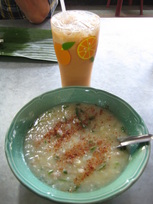 The one thing that Jeff talks about missing the most is breakfast. There is one breakfast dish here, jok – a rice porridge with a crazy amount of ginger, garlic, cilantro, and a few pieces of meat. It is quite delicious and really good for digestion but it can be hard to find, especially in tourist prone areas. For the most part we see Thais eating the same dishes for breakfast as they do for dinner. We still haven’t had a really spicy curry for breakfast yet – not sure my stomach can handle such a start! As we are immersing ourselves in Thai culture, which includes learning Thai, we are noticing that Thai verbs don’t have a past tense. This is quite intriguing from a Buddhist perspective. Would a linguistic lack of a past tense necessitate a greater connection to the present moment? Regardless, it does lead to a greater chance for confusion. Native Thai speakers have told us that formal conversations often have multiple questions strewn throughout to clarify things like tense, number, etc… What Thai lacks in complexity in those areas it makes up for with its five different intonations – the word ‘khao’ means 5 different things depending on how it is pronounced! And the alphabet is just insane with 44 consonants, each with an inherent vowel, and 18 other vowels. As you can see, travel is an endless observation of Same Same But Different, a Thai adage that neatly summarizes life. Neda and I visited Mae Sot last week. It’s a border town 7km from the Burmese border with a mixture of Thai, Burmese, and ethnic hill tribe peoples (many of whom come from Burma). This leads to a wonderful cultural mix with a diverse array of clothing (many men wear the Burmese longyis, or sarongs), crafts, languages, and food. But unfortunately, there is a dark side to the diversity. Outside of Mae Sot are 3 large refugee camps serving as home for over 100,000 displaced Burmese. They have fled the despotic military junta that currently reigns over Burma. We had the opportunity to volunteer at one of the migrant schools set up to educate the child refugees living in the area. The school, named Agape, is like other migrant schools in that it receives no funding from the Thai government, relying only upon international aid and donations to function. The stories we heard about the children living there need to be heard by more people, which is why we are writing this post. Some families in Burma can’t leave but want to send their children to Thailand so that they can have a better life. To be smuggled across the border they have to pay a “transporter”the equivalent of about $90. Of course they don’t have that kind of money so they are told the children can pay back the transporter when they arrive to work in Thailand. Once the kids are smuggled across, they are thrown into sweat shop factories run by local Thais and forced to work for years to pay off their debt. Or they are shipped around Southeast Asia and forced to work as sex slaves. One volunteer told us the heartbreaking story of a 9 year old Burmese girl who had been trafficked into Malaysia. They had to stop her from teaching the other kids the Malaysian she had learned because it was all related to explicitly sexual acts. She didn’t even know what she was saying. Mae Sot is awash in begging children. David, the founder of Agape School, told us that many of these kids are being forced to beg by their parents. Sometimes the parents live in Thailand after having crossed the border and sometimes the kids cross the dangerous river border and come across to beg, or as is more often the case, act as drug mules. The kids are less hassled by police and as such are now the most common drug dealers to be found in the streets of Mae Sot. It certainly gave me some perspective about “being put in the middle” to hear the stories of these children who are used only as tools by their parents or others. It’s the height of injustice that the most innocent in our society are those most often caught in the middle between people’s greed and delusion. The cynic can focus on all the suffering present in the place, though the optimist can point to people like David, who founded the Agape school with nothing but grit and determination. You can read a bit about his story by clicking here and see their facebook page, set up by a volunteer we befriended, here. In the end, as with all suffering, the first step we can take is to bring awareness to it. Suffering feeds on ignorance and distraction – the more light of awareness we can bring to the children of Mae Sot, the more the momentum for change will grow.
Neda and I often talk about just what it is we are doing on this mini-retirement/travel the world extravaganza. Sure, we want to experience diverse languages, foods, and climates, and we hope to make new friends and gain insights about the world. But in the end, we have distilled it down to one coined word: wonderlust. The desire to constantly have wonder in one’s life, whether one is trotting the globe or grinding through the typical work week. It is wonder that inspires us to create, to love, to truly feel alive. 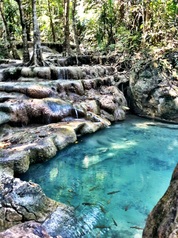 the fish awaiting their meal This past week has had no shortage of wonders. It started with the long trip from Southern Thailand up to the Kanchanaburi province of Central Thailand. Kanchanaburi contains the 7-tiered Erawan Waterfall, where each aquamarine curtain flows into a rippling pool fit for swimming before continuing on to the next fall. In each pool, a variety of fish will be swimming with you, some of which love to eat the dead skin cells off your legs and feet. It is a wondrous experience to take part in this temporary symbiotic relationship as the fish get some food and you get nature’s pedicure. Kanchanaburi also contains the infamous bridge over the River Kwai, built by Japanese captured POWs under horrid conditions during World War II. In total, thousands of soldiers from America, England, Australia, China and other countries lost their lives building the Siam-Burma railroad that runs through Kanchanaburi. It is here that we paused in wonder at how cruel man can be to his fellow man when greed and hatred reign the psyche. To see all the pictures from Kanchanaburi, both waterfalls and the bridge, go this link: http://flic.kr/s/aHsjyuhX64 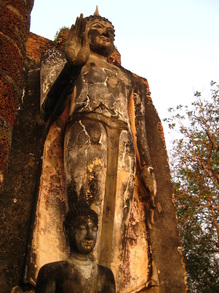 Buddhas at Sunrise Next, we headed north into the Central Plains of Thailand to visit the ancient city of Sukhothai. Established in the middle of the 13th century, this vast kingdom (considered to be the first distinctly “Thai” kingdom) ruled from the capital city for almost 200 years. As Neda and I bicycled through the 70 square kilometers of ruins at the site, we couldn’t help but marvel at the beautiful art and architecture that remains and at the obvious power of this kingdom that has long since faded to the sands of time. We watched the sun rise over the ancient city with our backs to a 45 foot Buddha on a hill outside of town – the same Buddha that the king of Sukhothai would visit on his white elephant come every Buddhist Sabbath. To see the rest of the wonderful pictures of the city of Sukhothai, go here: http://flic.kr/s/aHsjywxYDc 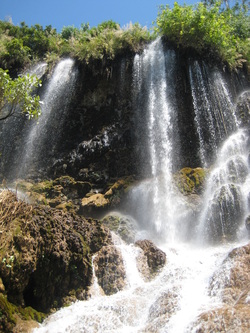 The Thararak Falls Finally, we headed west to a border town called Mae Sot. Sitting just 7 km from the Thai border with Burma, Mae Sot is a cultural melting pot of Thai, Burmese, Chinese, and native hill tribe peoples. We’ll go into that more in another post, but today we rented a motor bike and did a self guided tour of the Thararak, Pha Charoen, and Pa Wai Waterfalls, located over a 50 km stretch from the city. Each waterfall brought its own unique wonder, ending with the Pai Wai falls, the most mystical and enchanted waterfalls we have ever seen (see below). We left with a smile on our face and a sense that we will always carry with us the beauty we had seen – perhaps as an inspiration when wonder seems hard to find. To see the pics so far of Mae Sot, including the waterfalls and our visit to the Burmese Wat, click here: http://flic.kr/s/aHsjyBUtvM And yet all these amazing sites paled in comparison to the most wondrous event to happen this week in our lives. While traveling, we found out that our niece Ella spoke her first word! Even as we find wonder in our travels, our hearts are with my brother Dan and his wife Lauren as they find wonder in the little girl they have brought into the world. We love you Ella! Oh, and her first word was “cheese” in case you were "wonder"ing…
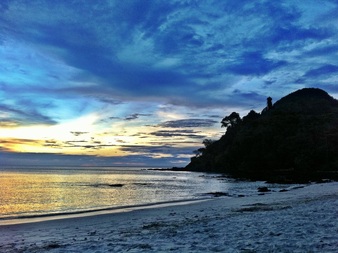 Sunset at Ko Mook "living plants are supple and yielding dead branches are dry and brittle an inflexible army does not triumph an unbending tree breaks in the wind thus the rigid and inflexible will surely fail while the soft and flowing will prevail" Excerpt from Tao Te Ching – Lao Tzu – chapter 76 It has been very intriguing to experience life as an extended traveler. It is full of new adventures every day, new people to meet, new foods to taste...just newness. And yet the constant change makes one crave the creature comforts we are used to in the States and Bulgaria. Here in Thailand we have had to get used to cold showers, non-potable water (you have to buy drinking water everywhere), no toilet paper in any bathrooms (BYOTP), stomach bugs, and sleeping on the floor or surrounded by mosquitoes with only a thin net protecting you. At first, we resisted some of these experiences and were like a stiff tree breaking in the wind. It only caused suffering and took us away from the experience. So we have been practicing shedding our preferences here in Thailand. To be o.k. with the shock of the cold water as it hits your skin or the buzz of the mosquitoes in your ear. It is in this way that travel makes us more pliant and more flexible and in the end, much happier. 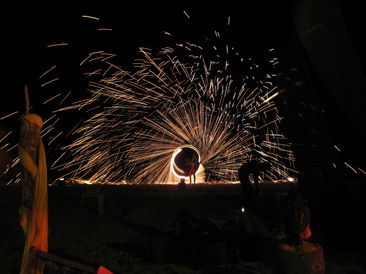 A fireshow on the beach in Ko Lanta As for the traveling, we loved our stay in Ko Lanta, especially after the business of Ko Phi Phi. It is a beautiful island covered in sprawling forest and jungle with multiple beaches lining its 30 km long coast. We stayed on the longest beach (3km long) and enjoyed fire shows, beautiful sunsets, and just simple "beach bumming". We also hiked through the jungle to get to Khao Mai Kaew cave where a local guide kept us safe while pointing out sleeping bats and giant spiders in the enshrouding darkness of the cave. See our pics from Ko Lanta here - http://flic.kr/s/aHsjyrxvQF. 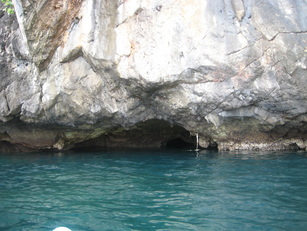 In the end, we couldn't resist one more island and headed to Ko Mook to see the famed Emerald Cave. To get into the cave, we sea kayaked from the beach around the island to this little hole in the limestone (see to the right). We passed through an 80 meter long tunnel partially in darkness and partially lit by the luminous green glow of the water within (thus the name of the cave). As we emerged through the other side, we were awestruck by the beauty of the lagoon within. All tourists had vacated and we were treated to turquoise water and a private beach surrounded on all sides by towering cliffs and lush forests. The lagoon is barely accessible by land, making the journey all the more spectacular. In fact, pirates used to store their treasures here back in the day. See the video of us emerging from the pitch blackcave into this little heaven! Also, check out all the pics from Ko Mook here - http://flic.kr/s/aHsjyrzPwg. So now that the islands are done we have headed north. We took an overnight train from Trang to Kanchanaburi (via a stop over at Nakhon Pathom to see Phra Pathom Chedi, the largest Buddhist monument in the world) and are looking forward to exploring the northern parts of Thailand. Here is a map of our island hopping journey and our movement on the night train:
|